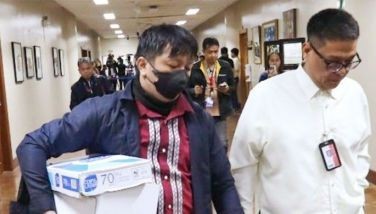Handumanan: A Collection of Santos
Photos by ReynanVillena
Collected over 20 years by Dr. Ramon and Rosita Arcenas, this special exhibit at the MuseoSugbo dubbed "Handumanan: The Arcenas Collection of Bisayan Santos," inaugurated last May 4, comprises of saints wrought in wood that form part of a remarkable gathering of ecclesiastical objects.
Included in the collection is the family "paso" that forms part of the grand but solemn Holy Week procession of life-size images in the town of Bantayan.
Also part of the collection are works made combining wood and ivory as well as rays and crowns in silver. These works of ecclesiastical art date to the late 1700s up to the early 1900s.
Featured are (but not limited to) the following:
*Carrosa/Caro.Bantayan is the hometown of the late Dr. Ramon Arcenas, the husband of Ms. Rosita Rodriguez Arcenas. It is one of three municipalities in Bantayan Island which is located west of the northern tip of Cebu. Aside from being known as the home of the "danggit" (a variety of dried fish) and the original "egg basket" of the Central and Southern Philippines, Bantayan Island is renowned for its Holy Week or "Semana Santa" tradition. It is considered the "Lenten Capital of the Visayas." Bantayan'sSemana Santa main attractions are the processions, held in the main streets of Bantayantown during the evenings of Maundy Thursday and Holy Friday, by richly decorated and brightly illuminated "carrozas" or "caros". These caros depict the scenes from the Passion and Death of Jesus Christ.
* Quita y Pone.Many images of the Spanish period had detachable heads and hands which were called "quita y pone" (literally, remove and insert). These detachable parts, often made of ivory, could be placed in a generic kind of carved body which would then be "dressed" or "attired" in the appropriate image corresponding to a particular saint as the need arose, a cost saving measure if ever there was one.
*San Isidro Labrador. Easily identifiable by his plain camisa, San Isidro Labrador, the patron saint of farmers, has always been one of the most revered saints in the Philippines. An angel stands beside him, tending the fields so San Isidro can attend Sunday Mass. Beside him is Juan de Vargas, his landlord, asking forgiveness for accusing San Isidro of laziness.
*San Roque. Is the patron for the sick and is one of the most revered saints of the Filipino family. He tended plague victims until he himself fell ill. Expelled from the town, he withdrew into the forest to die. A dog belonging to a local nobleman brought him bread and licked his wounds, healing him and saving his life.
*Kneeling Angel. Finely carved angel that served as candlestand. Had the hands survived, they would have clasped a silver or metal pole toppedbyacandelabra.
*Filipino Belen. This formally dressed adoring Filipino couple, attired in mid-19th century finery, used to be part of the belen - a Nativity tableau. This was a Filipino reinterpretation of the belen which depicted the Filipino way of life.
*The Apostles. A parish priest was about to bury these twelve blessed statues as part of church renovation. Mrs. Arcenas decided to save as much of these possible. She saved the heads because the five-foot bodies were too large to move. To this day, nobody has been able to name the heads of these twelve apostles.
*San Nicolas de Tolentino.A polychromed wooden image of San Nicolas de Tolentino, the patron saint of the Augustinian Recollect Province of the Philippines. Legend has it that San Nicolas, a vegetarian, was served a roast fowl over which he made the Sign of the Cross, after which it flew out of the window.
*San Guillermo de Maleval.Founder of a branch of the Hermits of St. Augustine. He can be identified by his beard and he would have held a crucifix and skull. Note the space in between his upper and lower garments, where a leather belt would have been fastened for devotees to kiss.
*Head of a Santo.The finely detailed head of either Jesus Christ or a saint. The chopped nose may have been a result of the penchant of Katipuneros during the 1896 revolution to cut off statues' tall, Hispanic noses to spite their colonial masters.
- Latest
- Trending



























